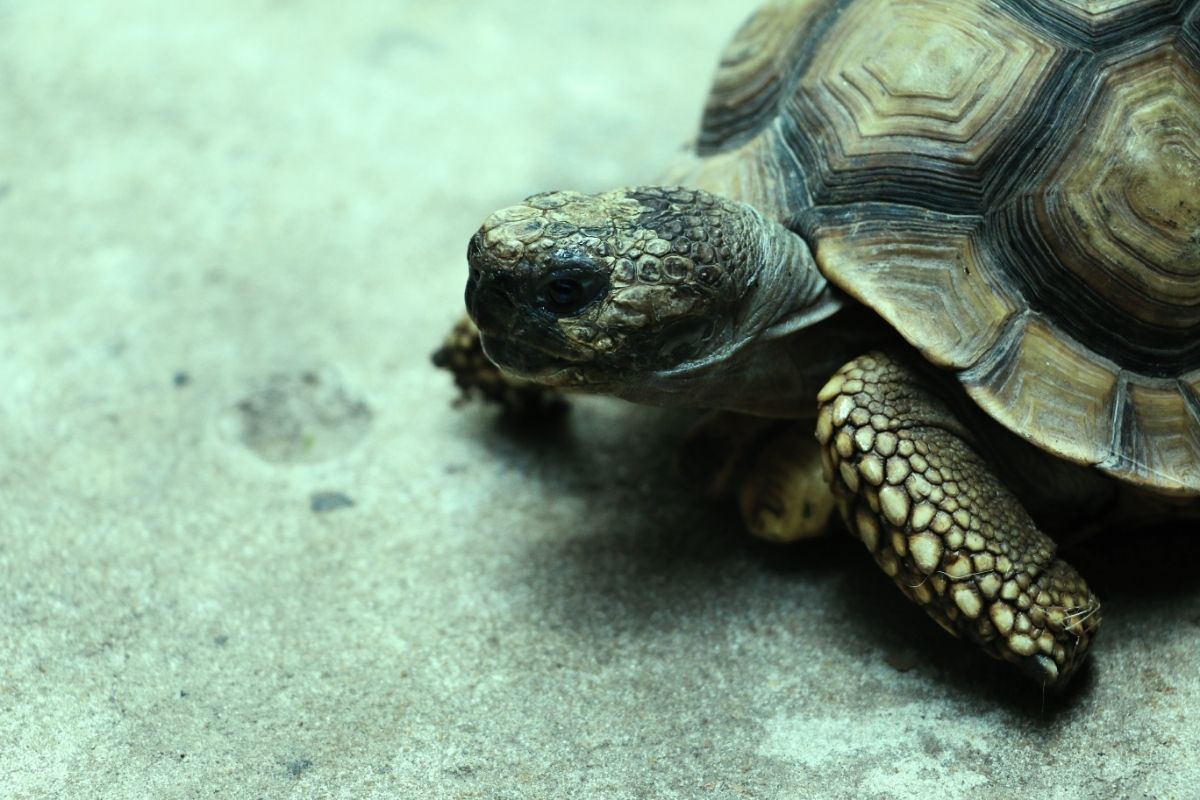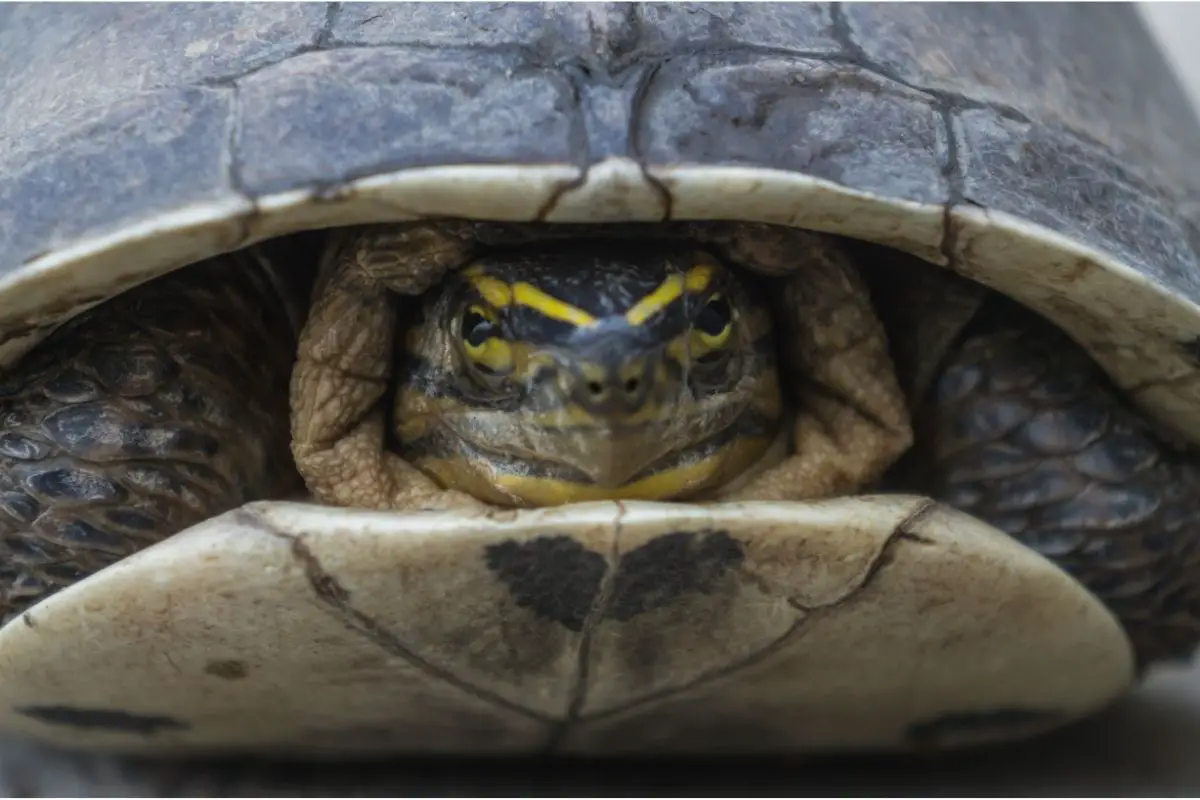Much like humans, temperature is essential for the survival of a turtle.
If you’re thinking about adopting a turtle, you might be wondering: Do turtles get cold?

In this article, I will explore some key information about turtles, including whether turtles get cold.
Without further ado, let’s get started.
Do Turtles Get Cold?
In short, yes, turtles get cold. If the temperature of their environment is too low, this can induce a state of brumation or hibernation (during the winter time).
During this process, they don’t really sleep or rest, but instead go into a state of suspended animation called torpor.
Torpor is a natural response to cold weather. In fact, it’s a common survival strategy for reptiles and amphibians. They enter a state of reduced metabolism and body temperature to conserve energy.
If your turtle’s tank is at a low temperature for too long, this can therefore cause your turtle to enter brumation. It’s important to note that brumation can be dangerous, particularly if your turtle goes into brumation.
So, how long does it take for a turtle to recover from brumation?
It takes a lot longer for a turtle to recover from brumation than it does for them to go into brumation. Your turtle might naturally awaken once the temperature inside their tank stabilizes.
Generally speaking, smaller turtles shouldn’t brumate for longer than 10 weeks, and larger species not longer than 14 weeks.
If you’re worried about brumation, make sure that you seek advice from your veterinarian so that you are better prepared to deal with the eventuality.
However, turtles aren’t able to withstand temperatures below a certain point. As a result, it can be fatal to your pet turtle if they’re exposed to extremely cold temperatures for a long stretch of time.
Why Do Turtles Get Cold?

Turtles are unable to regulate their body temperature. Unlike mammals and birds, which are both endothermic, all reptiles, including turtles, are ectothermic animals (cold blooded).
This means that they rely on external factors such as the air temperature and humidity to keep them warm or cool throughout the year.
When an animal gets too hot or cold, its nervous system sends signals to the brain that cause it to sweat or pant in order to maintain its internal temperature. This process is known as thermoregulation.
If you examine a turtle’s daily routine, you will notice that turtles alternate between spending their time in water or basking in the sun.
Once a turtle enters the water, their body temperature naturally adjusts to the temperature of the cold water. Eventually, the turtle will begin to feel cold whilst in the water and will climb out to bask in the sun.
Basking is essential to a turtle’s health. It allows them to synthesize Vitamin D.
In addition to this, the heat from the sun (or heat lamp) helps to raise their body temperature, compensating for the heat lost while swimming.
However, in the same breath, turtles cannot withstand temperatures that are too hot.
Once the turtle begins to warm up, it will eventually get back into the water to cool down. As a result, this basking and swimming routine perpetuates.
Turtles thrive when the temperature in their environment is just right. However, if it fluctuates, becoming too hot or too cold, this is when turtles can begin to struggle.
How Cold Is Too Cold For Your Turtle?
This largely depends on the species of turtle in question, as the temperature range can vary. That being said, the majority of pet turtles require their tank to fall within a range of 75 to 86 degrees Fahrenheit.
If your turtle’s environment falls out of this range, the cold may begin to affect its activity levels and metabolism.
It’s also important to note that while a turtle has the ability to cope with colder temperatures through the process of hibernating, they cannot survive cold conditions indefinitely.
A harsh winter or extreme temperatures have the potential to kill a turtle. This is why it’s essential that you have a reliable thermometer to regularly check the temperature of your turtle’s tank.
How Can You Tell If Your Turtle Is Too Cold?
There are a variety of signs that you can look out for to determine if your turtle might be too cold.
For instance, if your turtle is cold they might seem quieter and less active than usual. In addition to this, if they seem lethargic and they’re spending the majority of their time sleeping, then this could be a temperature issue.
You may also notice that your turtle’s appetite decreases or disappears completely, then it could be that they’re too cold.
Your turtle spending an increased amount of time basking under the heat lamp is also a sign that they are cold.
If they’re swimming less, and are spending more time under their heat lamp, then this is a sure sign that they’re cold.
If your turtle shows any of these signs, then it is a good idea to check the temperature of its tank. Leaving it to cope with low temperatures for too long may force it to brumate.
Staying in tune with your turtle and their needs is essential to their survival. If you don’t spot these signs early, they could become very sick.
To prevent this from occurring, make sure that you are regularly checking your turtle’s tank temperature.
If the temperature suddenly falls, you will need to make sure that you raise the temperature with other methods, such as an internal heater, to ensure your turtle is comfortable.
When it comes to owning turtles that spend the majority of their time in the water, you can use an internal water heater to warm the water.
What Do Turtles Do When They Become Too Cold?

There’s no denying that turtles are vulnerable to becoming cold. So, what do they do when this happens?
When your turtle becomes colder, their metabolism slows down as a natural response. When this occurs, your turtle enters a restful state that might seem different to their usual behavior.
In this restful state, your turtle will become lethargic, their activity levels will decrease significantly, and their blood circulation reduces.
In the process of reducing their metabolic rate, turtles require less energy and rely on fat reserves to survive. This is true until the temperature of their environment stabilizes once again.
What Can I Do To Help My Turtle Stay Warm?
The best way to help your turtle stay warm is to provide a constant source of heat. You could use a reptile heat mat or a reptile heat bulb. These devices emit infrared radiation that warms up your turtle’s surroundings.
Alternatively, you can also use water heaters, or direct sunlight. However, direct sunlight isn’t nearly as reliable as a heat bulb.
As a result, you will need to make sure that you are carefully monitoring the tank’s temperature to ensure that your turtle’s environment is warm enough.
In addition to this, there are other ways to ensure your turtle stays warm. Firstly, make sure that the tank has enough ventilation holes. Secondly, place some logs or rocks around the tank so that your turtle can hide underneath.
Do Turtles Get Cold At Night?
Typically speaking, the temperature at night tends to be colder than during the day.
In the wild, turtles will usually hide under rock piles, wedge themselves underneath logs, or bury themselves in leaves to ensure that they are warm enough during the night.
However, turtles that are kept in captivity as pets have the luxury of living in a regulated tank, so the switch from day to night won’t bother them as much as it would in the wild provided you’ve got their tank at the right temperature.
That being said, as I’ve already discussed, there are things that you can do to ensure that your turtle’s tank is the appropriate temperature at night.
Provided that you have a number of rocks and logs in your pet turtle’s tank, it is fine to turn off their basking light at night.
However, I can’t stress enough how important it is to build an environment that is similar to what they’d experience in their natural habitat.
By replicating the conditions that they’d experience in the wild, you will be providing them with an environment that they can flourish and thrive in.
Do Aquatic Turtles Get Cold?
Yes, aquatic turtles cannot regulate their body temperature and therefore rely on external heat sources in order to stay warm.
As a result, if you own pet aquatic turtles, you will need to make sure that the temperature of their tank water is just right.
If the water in their tank is too cold or too hot, your aquatic turtle can become sick very quickly. It’s important to note that some species of aquatic turtles are better equipped to deal with cold water temperatures.
However, these turtles will still require heat lamps or a heat source to bask under after their swim in order to raise their body temperature.
In the wild, aquatic turtles are able to sense the approaching season of winter. Generally speaking, their energy levels will reduce and many of them bury themselves into mud, where temperatures remain more stable throughout the winter season.
The length of time that aquatic turtles brumate for entirely depends on the temperature of the water that they reside in.
As a result, the location where they live will significantly affect how long the brumation period lasts.
A Note On The Temperature Of Your Tank
If you’re unsure of the exact temperature range for your species of turtle, you will need to make sure that you heavily research and also speak to your veterinarian.
Keeping your turtle in the right environment at the right temperature is absolutely crucial to ensure they are able to thrive in captivity.
In an ideal world, their tank should replicate their natural habitat in the wild, as this will give them the closest experience to their natural home to flourish in.
You need to make sure that you are prepared with a reliable thermometer, as well as all the equipment that you need to keep them happy and safe before you commit to buying a turtle.
After all, their health and happiness should always be your priority.
In Summary
Turtles get cold in both the wild and captivity. However, it’s important to understand how a turtle can get cold, and to install a reliable thermometer in their tank to check their environment regularly.
By understanding how to keep your turtle warm, you’ll be able to ensure that your turtle is safe and well-cared for.
